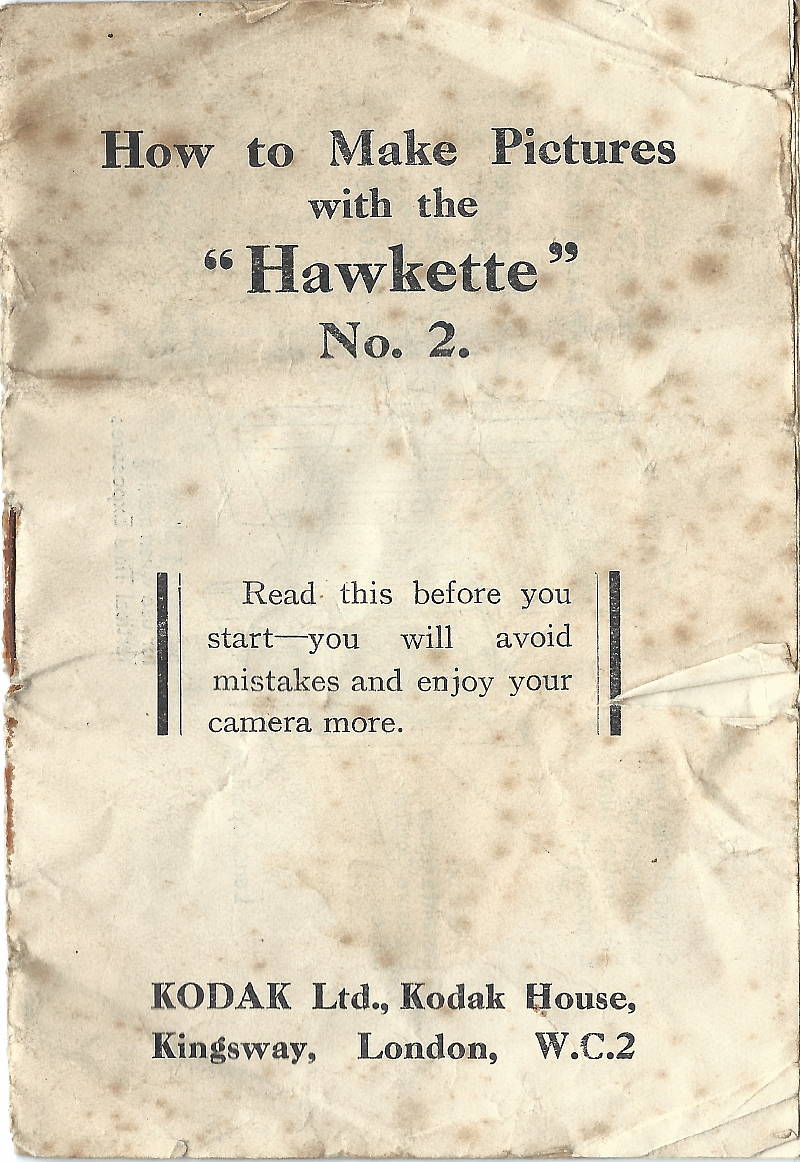No 2 Hawkette camera
Kodak Limited
| Name: | No 2 Hawkette |
| Manufacturer: | Kodak Ltd |
| Country of Origin: | United Kingdom |
| Construction: | Constructed from brown bakelite moulded components produced by E.K. Cole Ltd (Southend) and manufactured at the Kodak factory in Harrow, using some components brought in from Rochester. Refer to Notes for further details |
| Plate / Film Size: | 120 rollfilm |
| Lens: | Meniscus |
| Shutter: | Rotary |
| Movements: | None |
| Dimensions (w x h x l): | 9 x 18 x 4 cm (closed) |
| Production Period: | 1930 - ? |
|
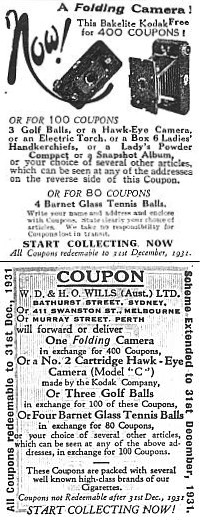 |
|
 |
The Kodak No 2 Hawkette was the first plastic bodied camera produced by Eastman Kodak (assembled by Kodak Limited in the UK), using bakelite components made by E. K. Cole Ltd (see Notes). The camera has a speckled finish, predominantly brown but streaked (or 'marbled') with darker colour. Shades vary between cameras and even between components on the same camera. This camera was apparently only produced for premium sales (Coe, Kodak Cameras The First Hundred Years [4], p115). It may have been introduced to compete with the APM Rajar No 6 camera introduced in 1929, which was also made of bakelite (this time moulded in plain black) and of a similar, though somewhat cruder, construction. I have not yet found any evidence to suggest that the No 2 Hawkette camera was ever produced for sale. The cameras were given away under premium schemes for a number of products including magazines, cigarettes and Cadbury chocolates. I have actual evidence of the first two but have as yet to find any solid evidence for the link with Cadbury, although it is stated in McKeown [1]. The picture on the left is a scan of a cigarette coupon from W.D. & H.O. Wills (Australia), which offers the choice between the folding camera or a No 2 Cartridge Hawk-Eye (Model C) box camera. I have several examples of the Kodak No 2 Hawkette camera that are complete with original boxes with the attractive yellow and blue Hawk shaped artwork. Two such examples are shown below. The box is made of corrugated card, and is not very strong. While the cameras are quite common and easy to find, the original packaging is relatively scarce - in all the time I have been collecting I have seen only a limited number of examples of this camera complete with the packaging. |
~ # ~ # ~
| Model / Variant: | Damage to bezel around lens opening |
| Date of this Example: | c1934 |
| Serial Number: | None |
| Availability: |
|
| Inventory Number: | 306 |
Description
This example of the No 2 Hawkette is complete with its postal box with great artwork. The camera is the form with the deep cone around the lens, with the inevitable fault at the 12 o'clock position (see comments under Notes below).
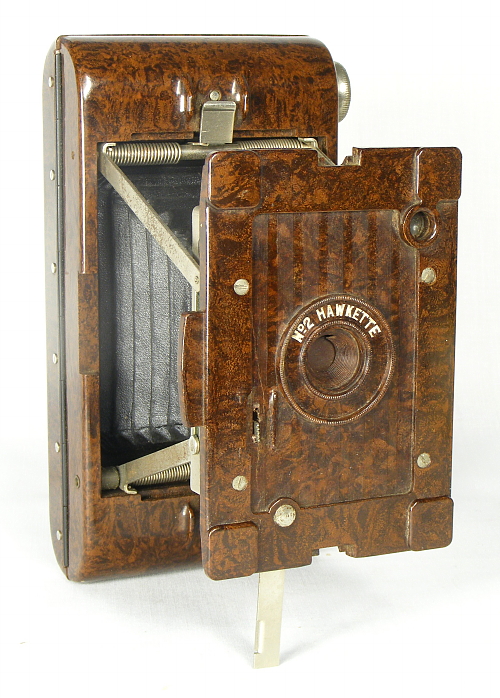
The original packaging is made of corrugated card and covered in coloured paper to provide the blue and yellow art deco artwork showing a flying hawk. The box ends are complete, but are separating into layers. Remains of original Kodak tape is in place around the edges of the box. The address label shows that the source was "Weekly Illustrated". Unlike the other boxed example, it also retains its inner cardboard ring that went around the camera.
According to the on-line records at the British Library, the "Weekly Illustrated" magazine did not enter circulation until 7 July 1934. This brings into question the limited production dates claimed, or suggests that stocks must have been available for a long period. This requires further investigation!
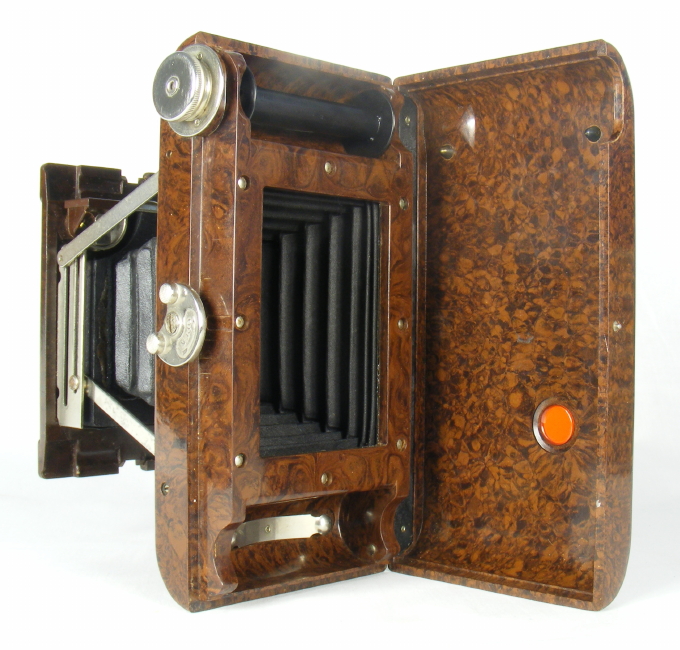
~ # ~ # ~
| Model / Variant: | Reduced depth bezel around lens opening |
| Date of this Example: | c1930 |
| Serial Number: | None |
| Availability: |
|
| Inventory Number: | 598 |
Description
This example of the No 2 Hawkette is also complete with its original packaging and the outer postal container, which is covered in black iridescent paper.
The camera itself is in good condition and is of what I believe to be an alternate form of the front panel that has a shallow cone around the lens (see Notes below).
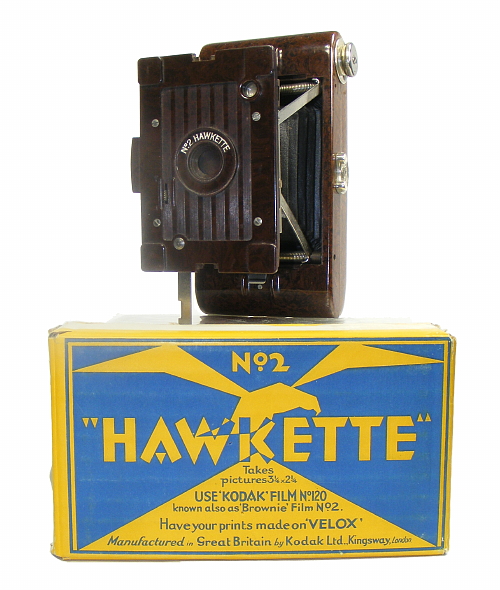
Notes
In common with other Kodak cameras such as the Brownie No 2, the number in the name relates to the film size (120) and does not indicate that there was ever a "No 1" model.
Brian Coe identified E.K. Cole as the maker of the bakelite components [4]. The company was based in Southend, Essex. Their records, such as exist, are now held by Southend Museum. Correspondence with the museum did not reveal any further information as sadly the pre-war records have not survived.
Dr. Michael Pritchard also checked the archives from Kodak Ltd., which were transferred to The British Library in 2011, but again was unable to find any further information about the premium schemes that used the camera or the maker of the bakelite components.
Most of the examples of this camera that you find have damage to the bezel around the lens that forms part of the moulding of the bakelite lens panel, which is mounted by four screws directly onto the shutter assembly. I spent many years looking for an undamaged example and discovered that all variants that I encountered with the full depth bezel show the same fault. Further investigation has revealed that without this missing section of the bezel, the shutter fails to operate.
The shutter itself is a simple single speed flip-flop shutter, which consists of a kidney-shaped blade that moves over the lens, powered by a V-shaped spring. The shutter lever has two positions and pushing it between them causes the shutter blade to flip first one way and then the other, powered by the spring. One end of the V-shaped spring is fixed to the shutter lever while the other is fixed to a boss mounted on the blade. The photograph below shows the shutter assembly; the red arrow identifies the boss.
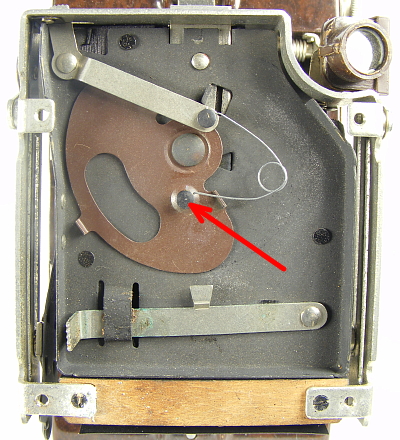
Careful examination of a camera with the full depth cone suggested that the raised boss fixed on the blade, which mounts one end of the shutter spring, travels through an arc that passes very close to the cone. A simple experiment with a piece of soft modelling clay pushed gently into the cone showed that the shutter then failed to fire. I then attached a thin piece of thread to the spring so that it could be forced to move through its full travel and this left a distinct gash in the soft clay, confirming that the arc travelled by the raised boss when the shutter fires intersects with the cone - or at least it would do so but for the missing segment.
Camera #598 is undamaged. However, examination will show that in this case the bezel is reduced in depth, presumably as a late design change. It is harder to find this variant, though I have seen several so mine is certainly not unique.
The photographs below show close up views of the full depth bezel (left) and reduced depth bezel (right). The edge of the boss can just be seen in the view on the left. Note too that the lettering on the two examples is also slightly different, which suggests that two different moulds were used for the two versions of the front panel.
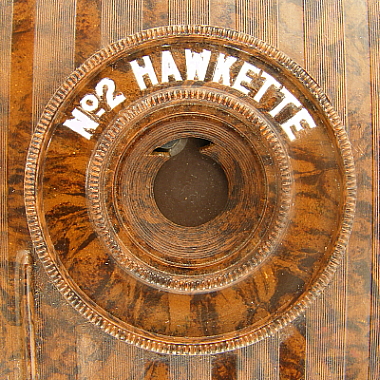 |
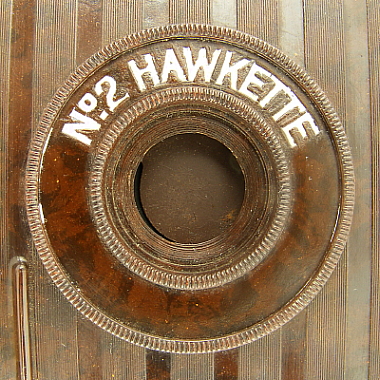 |
Note that the difference in colouration in these two views is representative of the actual body colour of the two cameras. The colour of the bakelite can vary quite significantly from a darker chocolate brown to a much more reddish-brown colour. I have also encountered examples where the colouration of the front panel and main body differ markedly.
The results of this investigation were first published in an article I wrote for Photographica World, the journal of the Photographic Collectors Club of Great Britain, edition No. 143 (Jan, 2013).
One of the other examples of this camera that I have with its original packaging also contained the original instruction booklet - these are also quite scarce.
It is also worth noting that the instructions identify the camera as the "Hawkette No 2", while the name marked on the body itself is "No 2 Hawkette".
In 2016 I was approached by Mathew Hargreaves from Los Angeles, who has set himself a goal of scanning and digitally restoring instructions for 120 rollfilm cameras to aid collectors or others who have an interest in these cameras. He has created a restored version of the instructions for this camera based on my original, which you can access as a PDF document by clicking on the image above. The document is made available here with kind permission of Mathew Hargreaves.
Other examples of bakelite cameras include the APM Rajar No 6, Coronet Vogue and Soho Cadet.
![[x]](../../images/checked.png)
![[ ]](../../images/unchecked.png)
